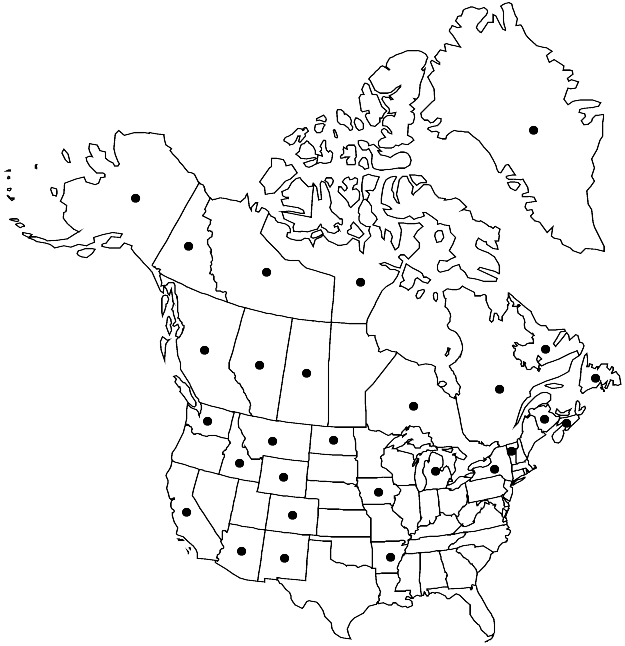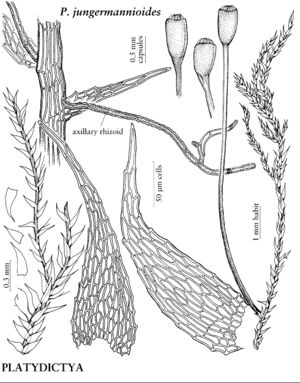Difference between revisions of "Platydictya jungermannioides"
Michigan Bot. 3: 60. 1964.
FNA>Volume Importer |
FNA>Volume Importer |
(No difference)
| |
Revision as of 22:02, 16 December 2019
Plants dense, soft, silky, green to yellow-brown. Stems with branching angle narrow, branches easily detached; pseudoparaphyllia absent; rhizoids axillary, purplish and granular-papillose at least when young. Leaves erect-spreading or sometimes ± secund, 0.1–0.3(–0.5) mm; base not or somewhat narrowed to insertion; margins serrulate, especially at insertion; alar cells subquadrate, region of 3–7 cells; distal laminal cells shortly oblong-rhomboid, 3–4:1. Specialized asexual reproduction by axillary obcuneate propagula. Sexual condition dioicous; perichaetial leaf margins ciliate-dentate distally. Seta 0.6–1.1 cm. Capsule erect, oblong-cylindric, symmetric or nearly so, 0.5–1 mm, contracted below mouth and at neck when dry, neck short; stomata in neck; annulus 2-seriate; operculum convex-conic, stoutly mammillate to ± rostellate; exostome teeth whitish yellow; endostome cilia 1 or 2, rudimentary to well developed. Spores 11–13 µm.
Habitat: Rock in damp, sheltered places, crevices of cliffs, under rock ledges, peaty soil, humus under overhanging turf, hollows under roots of trees, lower sides of logs, calcareous habitats
Elevation: low to high elevations
Distribution

Greenland, Alta., B.C., N.B., Nfld. and Labr., N.W.T., N.S., Nunavut, Ont., Que., Sask., Yukon, Alaska, Ariz., Ark., Calif., Colo., Idaho, Iowa, Mich., Mont., N.Mex., N.Y., N.Dak., Vt., Wash., Wyo., Europe, Asia.
Discussion
Platydictya jungermannioides is easily recognized by its small size, absent or almost absent leaf costa, easily detached branches, and axillary rhizoids that are purplish and granular-papillose at least when young. The branching and rhizoid characters differentiate P. jungermannioides from the other three species of Platydictya.
Selected References
None.
